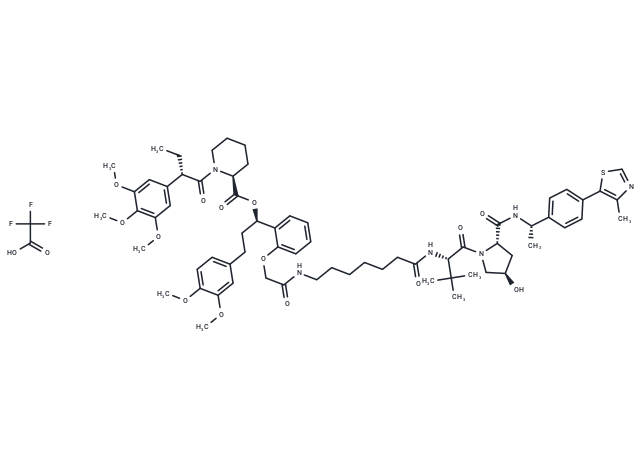Shopping Cart
Remove All Your shopping cart is currently empty
Your shopping cart is currently empty
dTAGV-1 TFA is a highly effective and specific compound that targets mutant FKBP12 F36V fusion proteins for degradation. It possesses potent activity in inducing the degradation of the FKBP12 F36V -Nluc protein in living organisms.

| Pack Size | Price | USA Warehouse | Global Warehouse | Quantity |
|---|---|---|---|---|
| 5 mg | $1,850 | 35 days | 35 days |
| Description | dTAGV-1 TFA is a highly effective and specific compound that targets mutant FKBP12 F36V fusion proteins for degradation. It possesses potent activity in inducing the degradation of the FKBP12 F36V -Nluc protein in living organisms. |
| In vitro | dTAGV-1 TFA (0.1 nM-10 μM; 24 h) effectively induces the degradation of FKBP12 F36V-Nluc without impacting FKBP12 WT-Nluc in 293FT cells[1]. Co-treatment with THAL-SNS-032 (125-2000 nM; 24 h) leads to significant degradation of both LACZ-FKBP12 F36V and CDK9[1]. At 500 nM over 1-24 h, dTAGV-1 TFA rapidly degrades KRAS G12V and pERK1/2[1]. Additionally, dTAGV-1 TFA (50-5000 nM; 24 h) promotes the degradation of EWS/FLI in Ewing sarcoma[1]. |
| In vivo | dTAGV-1, administered intraperitoneally (i.p.) at a dosage of 35 mg/kg once daily over four days, successfully induced the degradation of FKBP12 F36V-Nluc in mice. This effect was initially observed through a significant reduction in bioluminescent signal four hours after the first and subsequent three administrations, with notable degradation evident 28 hours following the final dose. Additionally, dTAGV-1 demonstrated pharmacokinetics and bioavailability at doses of 2-10 mg/kg (i.p.), showing half-lives of 3.64 and 4.4 hours, maximum serum concentrations (Cmax) of 595 and 2123 ng/mL, and extensive exposure (AUCinf) of 3136 and 18517 h ng/mL. When administered intravenously (i.v.) at 2 mg/kg, dTAGV-1 exhibited a half-life of 3.02 hours, a Cmax of 7780 ng/mL, and an exposure of 3329 h ng/mL. The animal model used consisted of 8-week-old immunocompromised female mice, transplanted with MV4;11 luc-FKBP12 F36V cells, to assess the compound's efficacy in inducing targeted protein degradation. |
| Molecular Weight | 1361.58 |
| Formula | C70H91F3N6O16S |
| Cas No. | 2624313-15-9 |
| Relative Density. | no data available |
| Storage | Powder: -20°C for 3 years | In solvent: -80°C for 1 year | Shipping with blue ice/Shipping at ambient temperature. |
| Size | Quantity | Unit Price | Amount | Operation |
|---|

Copyright © 2015-2025 TargetMol Chemicals Inc. All Rights Reserved.